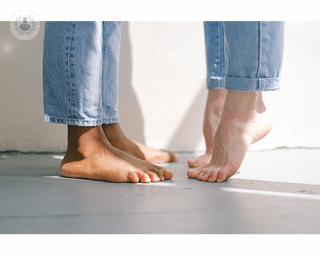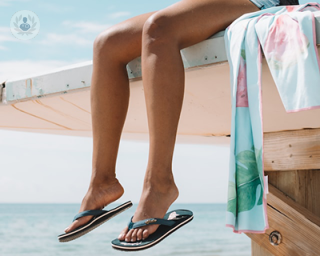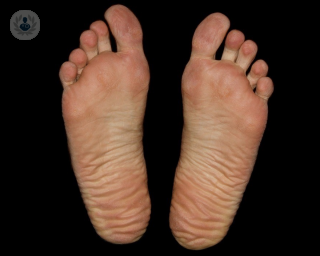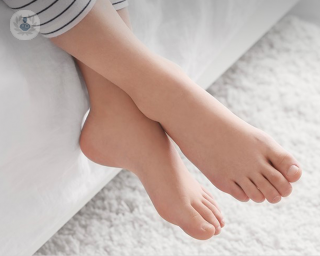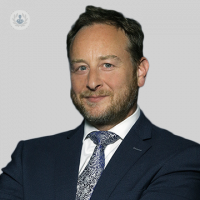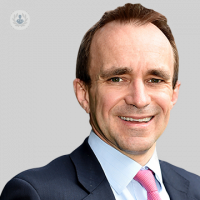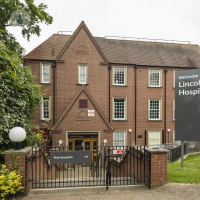Flat feet
Mr Thomas Crompton - Paediatric orthopaedics
Created on: 11-13-2012
Updated on: 06-15-2023
Edited by: Carlota Pano
What are flat feet?
The arch, or instep, of the foot is the part in the middle of the foot that is usually raised off the ground. Flat feet are when the arches of the feet are very low or non-existent, in some cases lying completely flat against the ground. They may occur due to weakness in the tendons in that area.
It is a common condition, especially in children, whose arches may develop as they grows up.
There are two types: rigid flat foot, which has no arch under any circumstances, and flexible flat foot (the most common type), in which the foot flattens when pressed on the ground, but when raising it, the arch reappears.
What are the symptoms of flat feet?
Before two years of age, flat feet are impossible to detect, because until then, the feet have a layer of fat and soft tissue on the sole. The insteps form in most children between the ages of three and five. After this age, the key symptom of flat feet is the flat appearance of the foot, without an arch.
Generally, flat feet do not cause pain when walking or making any movement, but some patients may experience pain in the feet, ankles, or even higher up in the legs, hips and lower back. This pain may get worse when moving around, and swelling can occur around the ankles.
What causes flat feet?
There are several possible causes of flat feet. In babies and toddlers, flat feet are normal, as the arch hasn’t formed yet. Even older children may have flexible flat feet, where the arch only appears when the child is not putting pressure on the sole of the foot, e.g. when sitting.
As this is due to the fact that the arch is still developing, most children with flexible flat feet will grow out of them. In other cases, flat feet may be caused by the following:
- Genetics – if your parents had flat feet you are more likely to also have them.
- Congenital conditions – if the foot bones didn’t form properly in the womb, flat feet may be the result.
- Conditions such as Ehlers-Danlos or Marfan syndrome.
- Conditions that affect the muscles or nerves, such as spina bifida or muscular dystrophy.
- Overuse, injury, ageing, and general wear-and-tear can cause the arch to collapse in adults, leading to flat feet. Contributing factors could include unsupportive footwear, obesity, or rheumatoid arthritis.
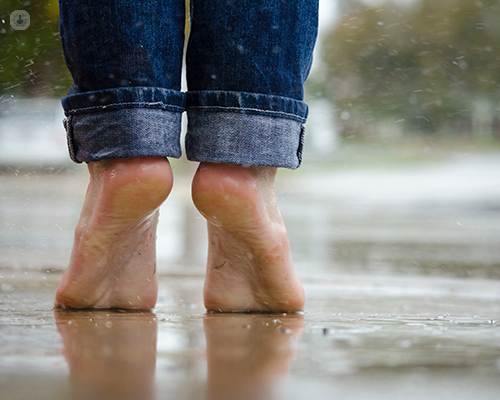
Can flat feet be prevented?
Most of the causes of flat feet are impossible to prevent.
However, you can minimise your chances of developing flat feet in adulthood by taking care of your feet. Some steps you can take include:
- Make sure your shoes are the correct size, and fit well, supporting the foot.
- Try not to over-exert your muscles when doing sport or exercise.
- If you notice that the arch in one or both of your feet is disappearing, visit your doctor, who may recommend exercises or therapy.
What is the most effective treatment?
Most cases of flat feet do not cause the patient any problems, in which case, no treatment is necessary. In cases where flat feet cause pain, the following treatments may be advised by the patient’s doctor:
- The use of insoles, supportive shoes or arch supports when walking.
- If the patient is overweight or obese, losing weight is strongly recommended.
- Painkillers and anti-inflammatories can help manage the discomfort and any inflammation
- Physiotherapy and stretching exercises can help to strengthen the connective tissue, particularly in cases of overuse and injury.
If more conservative treatments fail, or if there is an underlying condition, there are surgical options. If bones are abnormally shaped or joined together, surgery may involve straightening and separating them. If the problem is in the connective tissue, surgery may involve lengthening or repairing this tissue.

